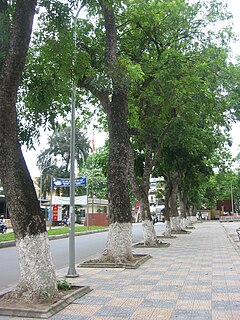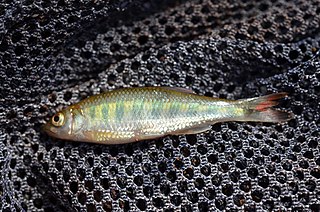
The Senegal bushbaby, also known as the Senegal galago, the lesser galago or the lesser bush baby, is a small, nocturnal primate, a member of the galago family Galagidae.

The mosque swallow, is a large swallow. It is a resident breeder in much of Sub-Saharan Africa, although most common in the west. It does not migrate, but will follow the rains to some extent.

The laughing dove is a small pigeon that is a resident breeder in Africa, the Middle East and the Indian Subcontinent. This small long-tailed dove is found in dry scrub and semi-desert habitats where pairs can often be seen feeding on the ground. A rufous and black chequered necklace gives it a distinctive pattern and is also easily distinguished from other doves by its call. Other names include laughing turtle dove, palm dove and Senegal dove while in India the name of the little brown dove is often used. It was introduced in Western Australia and has established itself in the wild around Perth and Fremantle.

Khaya is a genus of five species of trees in the mahogany family Meliaceae. The timber of Khaya is called African mahogany, and is valued as a substitute to genuine mahogany.

The white-bellied bustard or white-bellied korhaan is an African species of bustard. It is widespread in sub-Saharan Africa in grassland and open woodland habitats.

The scarlet-chested sunbird is a species of bird in the Nectariniidae family. It is found in Angola, Benin, Botswana, Burkina Faso, Burundi, Cameroon, Central African Republic, Chad, Democratic Republic of the Congo, Ivory Coast, Eritrea, Ethiopia, Gambia, Ghana, Guinea, Guinea-Bissau, Kenya, Malawi, Mali, Mauritania, Mozambique, Namibia, Niger, Nigeria, Rwanda, Senegal, Sierra Leone, South Africa, Sudan, Swaziland, Tanzania, Togo, Uganda, Zambia, and Zimbabwe.

Khaya senegalensis is a species of tree in the Meliaceae family that is native to Africa. Common names include African mahogany, dry zone mahogany, Gambia mahogany, khaya wood, Senegal mahogany, cailcedrat, acajou, djalla, and bois rouge.

Boscia senegalensis, commonly known as hanza, is a member of the family Capparaceae.

Raiamas senegalensis is a species of cyprinid fish in the genus Raiamas from western Africa east to the River Nile. It sometimes is found in the aquarium trade.

Olenecamptus is a genus of longhorn beetles of the subfamily Lamiinae.
Olenecamptus indicus is a species of beetle in the family Cerambycidae. The species was first described by Stephan von Breuning in 1936, originally under the genus Cylindrepomus. They have since been reclassified as part of the Olenecamptus genus.
Olenecamptus pseudostrigosus is a species of beetle in the family Cerambycidae. It was described by Stephan von Breuning in 1938.
Olenecamptus optatus is a species of beetle in the family Cerambycidae. It was described by Pascoe in 1866. It is known from Thailand, Singapore, Malaysia, Sumatra, Vietnam.
Olenecamptus strigosus is a species of beetle in the family Cerambycidae. It was described by Pascoe in 1866. It is known from Moluccas, Indonesia, and Papua New Guinea.
Olenecamptus vittaticollis is a species of beetle in the family Cerambycidae. It was described by Heller in 1923, originally as a subspecies of Olenecamptus optatus. It is known from the Philippines. It contains the varietas Olenecamptus vittaticollis var. divisus.
Olenecamptus albidus is a species of beetle in the family Cerambycidae. It was described by Jordan in 1894.

Olenecamptus bilobus is a species of beetle in the family Cerambycidae. It was described by Johan Christian Fabricius in 1801, originally under the genus Saperda. It is known from Myanmar, India, Papua New Guinea, Indonesia, Laos, Seychelles, Madagascar, Australia, Sri Lanka, Japan, Sumatra, Java, Philippines and Taiwan.
Olenecamptus cretaceus is a species of beetle in the family Cerambycidae. It was described by Bates in 1873.
Olenecamptus hofmanni is a species of beetle in the family Cerambycidae. It was described by Quedenfeldt in 1882. It is known from Ghana, Cameroon, the Democratic Republic of the Congo, the Republic of the Congo, Tanzania, the Central African Republic, Gabon, Angola, Malawi, the Ivory Coast, South Africa, and Zimbabwe. It contains the varietas Olenecamptus hofmanni var. dimbokro.
Olenecamptus indianus is a species of beetle in the family Cerambycidae. It was described by Thomson in 1857, originally under the genus Authades. It is known from Myanmar, Malaysia, Vietnam, Thailand, and India. It contains the varietas Olenecamptus indianus var. salweeni.













